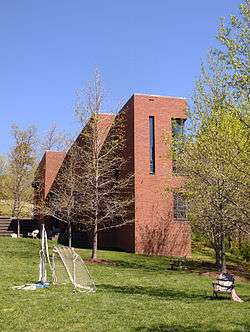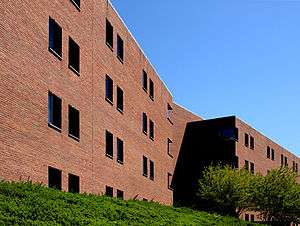Hereford College
 | |
| Type | Residential college |
|---|---|
| Established | 1992 |
| Principal | Wendy Cohn |
Academic staff | SR: Vignesh Kuppusamy |
| Students | 204 |
| Undergraduates | 200 |
| Postgraduates | 4 |
| Location |
Charlottesville, Va., USA 38°1′48.2″N 78°31′10.6″W / 38.030056°N 78.519611°WCoordinates: 38°1′48.2″N 78°31′10.6″W / 38.030056°N 78.519611°W |
| Campus | 2 residence halls, 1 principal's house |
| Leadership | Hereford Student Senate |
| Colors | Blue and Green |
| Affiliations | University of Virginia |
| Website | Hereford.virginia.edu |
Hereford College is a self-governed residential college at the University of Virginia that originally housed 500 students, mostly in single-occupancy rooms. Its stated core values are environmental sustainability, cultural diversity, and community outreach. Originally comprising 5 dorms within one area complex, the residential college has since been reduced to 2 dorms. Thus, only about 200 students reside as part of Hereford College; the rest are designated as normal undergraduate on-grounds students.
Named after physicist Frank Hereford, who was President of the University between 1974 and 1985,[1] the college opened in 1992 as New College, UVA's second residential college. It consists of five strikingly thin dorm buildings, a principal's building, and its own residential cafeteria. Hereford was designed by Tod Williams Billie Tsien Architects, which also designed the American Folk Art Museum in New York, the Neurosciences Institute in San Diego, and the Student Art Building of Johns Hopkins University.[2]
Student life
The college is unique among UVA housing in that most of the rooms are single occupancy, meaning that most Herefordians do not share a room with a roommate or suitemate. This may afford more privacy than other housing on Grounds. However, first years still typically share a room, which given Hereford's unique structure, can lead to lifelong connections and unions.
As Hereford is located behind the Dillard House complex and basically hidden from the rest of Grounds, it can feel quite remote. In actuality it is less than ½ of a mile from Scott Stadium and the first-year "New Dorms" along Alderman Road, and within 1 mile of virtually every undergraduate class taught at the University.
Only students in Norris and Whyburn dorms are considered part of Hereford College. As such, students living in Johnson, Malone, and Weedon dorms, while still having access to many of the facilities within the complex (such as Runk Dining and the computer lab), do not have access to much of the activities planned by Hereford College.
Programming
Paid for in part by a small membership fee, Hereford students regularly go on free or heavily subsidized trips together. Past examples have included trips to Monticello, hiking in the Shenandoah National Park, private viewings at the Fan Mountain Observatory, baseball games of the Washington Nationals and Baltimore Orioles, and weekend trips to Atlanta and New York City. Programs are organized by current residents as well as alumni.
Short Courses
Hereford offers weekly short courses open only to its residents. Recent topics have included Japanese animation, underground hip hop, the relationship between food, film, and culture, and introduction to academic research and scholarly activities.
Clubs
Clubs are student initiated and organized groups with a wide variety of interests. Membership is open to all Hereford residents and their friends from U.Va. Among some of the clubs currently offered at Hereford are the Cooking Club, Poetry Club, Soccer Club, and Volleyball Club.
Banquets
One night each month, Hereford members all dine together at a scheduled time in the banquet hall. The dinners are usually themed, with examples over the years including Crab Fest, Japanese Night, Latin Cultures Night, and Pumpkin Feast.
Pre-Game BBQ
Before every Virginia football home game, there is a BBQ cookout open to all Hereford students. Usually this is a couple hours before the kickoff at nearby Scott Stadium.
Runk Carnival
At the end of classes each year, there is a carnival at Hereford, in front of the Runk dining hall. Free attractions include a mechanical bull and a freefall slide.
Architecture

The modernist architecture of Hereford College won great acclaim when the residential college was unveiled. The New York Times said glowingly "it is more different from Jefferson than anything that has been built at the University in generations, but it rises to challenge him[4]" and in a later article the New York paper seemed to imply that all of New York City was jealous of the new dorm complex, stating "but for an international city, New York is sadly lacking in contemporary world-class buildings. And the lack is especially glaring considering how many world-class talents live here. Where are the buildings that can compare in formal intelligence to... Williams and Tsien's New College at the University of Virginia?[5]"
2008 Battle with Housing Division
Hereford College nearly ceased to exist when in November of its 17th year of operation, housing officials declared that Hereford would begin to house only first-year students and they would not be part of any residential college arrangement.[6] This was due to the razing of the Alderman Road "New Dorms" first-year housing area and a need to relocate students during the disruption.
The members of Hereford fought back against the administration, and won back their college in a stunning reversal. The Cavalier Daily praised Hereford students for being "role-models of student activism" and the "epitome of grassroots action rarely seen at this institution" after Hereford students wore I AM HEREFORD t-shirts for days and flooded administrative offices with phone calls and emails about the subject.[7]
Many of the displaced first-years were instead housed at Dillard House, a former upper-class housing area located just down the hill. Hereford College itself, however, was reduced to 2 dorms, with only Norris and Whyburn allocated for Hereford College. Johnson, Malone, and Weedon are only open to upperclass and transfer students in a non-residential college setting, ie, they are now normal upperclass dorms.
Hereford Scholars Research Award

In fall 2009, a Hereford Scholars Research Award was established with five recipients. Each researcher, chosen only from among Hereford College members, will receive $2000 for equipment and travel to work with a faculty adviser over the course of a year and present a final research paper at a Hereford Scholars research symposium.
Projects planned by the award winners in its first year include studying locally available restaurants and Runk Dining Hall to quantify the amount of high fructose corn syrup, designing a Smart Meter to charge electric cars at the least expensive and most environmentally friendly off-peak hours, analyzing reading comprehension materials from local schools and their effectiveness for children of socioeconomically diverse backgrounds, and experimenting to find the most efficient dispersal methods for waste water.[8]
Other Student Projects
An alfresco plaza was designed for the entrance to Runk Hall in August 2009 by a pair of Hereford students, Nathan Foley and Kate Goodman. Indigenous vegetation such as sweetbay magnolia and black gum trees, as well as blueberry and chokeberry bushes were utilized in the design[9] and, as always, sustainability was a prime consideration for the project.
Orientation
Hereford has hosted Summer Orientation for all new students at UVA since 1999.[10]
Grounds

The original five dorms are arranged in rows of two, two, and one, ascending a hillside. Left to right, from the bottom to the top, they are Weedon, Whyburn, Norris, Malone, and Johnson. Unfortunately, Hereford Residential College, which was originally composed of these five dorms, has now been reduced to Norris and Whyburn alone. The Senior Resident of Hereford lives in the basement floor of Whyburn. Vaughn Hall is the principal's building where the principal of Hereford College lives, and also has some space available for student activities. Runk Hall is the dining facility.
The buildings were named after the following faculty members at the University.[11]
- Nathan Johnson, Sr. (1909–1980) — professor of Education
- Dumas Malone (1892–1984) — professor of History
- Betty Norris (1927–1984) — professor of Nursing
- Benjamin Runk (1906–1994) — professor of Biology and University Dean
- Joseph Vaughan (1905–1999) — 1st Provost of the College, 1956–1960
- William Weedon (1908–1984) — professor of Mathematics and Philosophy
- Gordon Whyburn (1904–1969) — professor of Mathematics
Principals
Since 1992, there have been five Principals of Hereford College.[12] They and their families have lived in Vaughn Hall at the top of the hill. Oddly enough, so far each Principal has been a professor of either Architecture or Physics.
- Melvin Cherno — Physics (1992–1996, 2000)
- Daniel Bluestone — Architecture (1996–1999)
- Louis Bloomfield — Physics (2001–2007)
- Nancy Takahashi — Architecture (2007–2013)
- Wendy Cohn — (2013–present)
Famous Alumni
- Julie Macklowe (née Julie Lerner) – New York socialite, hedge fund manager, and founder of Vbeauté cosmetics company (lived in Norris Hall in 1996-97)
External links
References
- ↑ Frank L. Hereford Jr.; Physicist, U-Va. President retrieved April 16, 2009
- ↑ The Washington Post: Evermay's History retrieved April 16, 2009
- ↑ ARCHITECTURE VIEW; Jefferson's Legacy: Dialogues With the Past - The New York Times - May 23, 1993 retrieved April 16, 2009
- ↑ ARCHITECTURE VIEW; Jefferson's Legacy: Dialogues With the Past - The New York Times - May 23, 1993 retrieved April 16, 2009
- ↑ A Nervous Prism Of a Building For Manhattan - The New York Times - September 23, 1993 retrieved April 16, 2009
- ↑ Hereford Will House Only First Years retrieved November 21, 2009
- ↑ Round One, Hereford retrieved November 21, 2009
- ↑ Five Hereford Students Win First Annual Research Award retrieved November 21, 2009
- ↑ Students Create Livable Space Outside Runk retrieved November 21, 2009
- ↑ Orientation meets mixed reaction - September 6, 1999 retrieved April 16, 2009
- ↑ Hereford History retrieved April 16, 2009
- ↑ Hereford History retrieved April 16, 2009
- ↑ The Dillard Experience retrieved November 21, 2009
